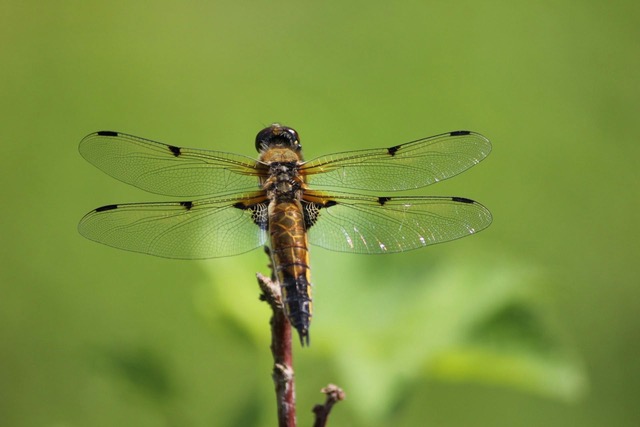A study by Kim Medley and others found that dragonflies with dark wing markings have a lower risk of extinction.
Visit one of Forest Park’s many lakes this summer and you’re likely to see dragonflies shimmering in brilliant shades of green, blue, and red. Look closely and you might notice a few with extra flash: dark wing markings that make them dazzle on a sunny day.

Those markings aren’t just cosmetic. A new study suggests that “ornamented” dragonfly species are better able to survive habitat destruction and other human threats. “It’s a strong correlation,” said co-author Kim Medley, director of the Tyson Research Lab. “Ornamented dragonflies seem to have an advantage.”
The study's lead author is Michael Moore, a former postdoctoral researcher with the Living Earth Collaborative who is now an assistant professor at the University of Colorado at Denver. Noah Leith, another co-author, is a former graduate student at Saint Louis University who is now a postdoctoral researcher at the University of Pittsburgh.
For one part of the study, researchers looked at records of 19 dragonfly species in California going back to 1900. Over that period, four species became significantly scarcer and three of those lacked ornaments. On the other hand, eight of the 10 species that became more common in the last 120+ years had the distinctive markings. Researchers concluded that ornamented species were far more likely to thrive over the long term.
The team also checked the current status and population trends of 311 species across North America, including 111 ornamented species. The good news for dragonfly fans is that almost all species — 301 out of 311 — are at little to no risk of extinction. The remaining 10 imperiled species all had something in common: They lacked ornamentation.
To better understand the threats faced by the insects, researchers gathered 90,000 observations of dragonflies made by amateur naturalists in the Midwest, including sightings in the St. Louis area. They compared the distributions of species across different landscapes, including cities, farms, and relatively wild forests and meadows.

Across the Midwest, researchers found a higher proportion of ornamented dragonflies in urban and agricultural areas, suggesting the markings offered an advantage in disturbed habitats.
Why does ornamentation matter? Researchers suspect that the tell-tale spots on the wings make it easier for females to identify potential mates and for males to spot potential rivals. These markers could be especially important for populations fragmented by habitat loss, Medley said. “We think ornamentation comes into play when populations become more isolated.”
But ornamented species are still the minority, and there are plenty of reasons why the added markers can cause problems. As Medley explains, those flashy spots can draw the attention of predators. They can also absorb extra heat, a downside on a hot summer day. “There’s a trade-off,” Medley said.
Header image: Pexels




